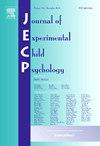基于具身认知理论的中国武术教学干预对5 - 6岁儿童注意网络的影响
IF 1.8
2区 心理学
Q3 PSYCHOLOGY, DEVELOPMENTAL
引用次数: 0
摘要
为了研究不同的中国武术教学方式是否对学龄前儿童的注意网络有不同的促进作用,本研究招募了90名5-6岁的幼儿园儿童,M = 5.5±0.2,随机分为武术感官教学(MAST)组、武术传统教学(MATT)组和自由活动(FA)组。两个武术组都接受了为期10周的干预(2次/周,30分钟/次),而FA组则参加了没有武术成分的户外自由游戏。使用儿童版本的注意网络测试(ANT)评估干预前后的警报、定向和执行控制网络。基线结果显示,在所有三个网络中,各组间无显著差异(p >;0.05)。干预后,MAST组的报警评分显著低于FA组(p = 0.02, d = 0.75),而MAST组与MATT组之间无显著差异(p >;0.05, d = 0.58),或在MATT和FA之间(p >;0.05, d = 0.17)。在执行控制方面,MAST组优于MATT组(p = 0.03, d = 0.95)和FA组(p <;0.01, d = 1.32),而MATT组也超过FA组(p = 0.04, d = 0.57)。各组间定向无显著差异(p >;0.05)。本研究的结论是,MAST显著增强了5 - 6岁儿童的执行控制和警报网络的发展,与MATT相比表现出更好的疗效。研究结果表明,基于具身认知理论的动态任务设计和多感觉反馈机制有效地促进了学龄前儿童注意网络的发展。本文章由计算机程序翻译,如有差异,请以英文原文为准。
The influence of Chinese martial arts teaching intervention based on embodied cognition theory on attention networks in 5–6-year-old children
To examine whether distinct Chinese Martial arts teaching approaches differentially enhance attention networks in preschoolers, this study enrolled 90 kindergarten children (5–6 years, M = 5.5 ± 0.2) randomly allocated to three groups: Martial arts sensory teaching (MAST) group, Martial arts traditional teaching (MATT) group, or a free activity(FA) group. Both Martial arts groups received 10-week interventions (2 sessions/week, 30 min/session), while the FA participated in scheduled outdoor free play without martial arts components. Alerting, orienting, and executive control networks were assessed pre- and post-intervention using the child version of the Attention Network Test (ANT). Baseline results showed no significant differences across groups in all three networks (p > 0.05). Post-intervention, MAST group exhibited significantly lower alerting scores than the FA (p = 0.02, d = 0.75), No significant differences were observed between MAST and MATT (p > 0.05, d = 0.58), or between MATT and FA (p > 0.05, d = 0.17). For executive control, the MAST group outperformed both the MATT group (p = 0.03, d = 0.95) and FA (p < 0.01, d = 1.32), while the MATT group also surpassed FA (p = 0.04, d = 0.57). No significant differences emerged in orienting across groups (p > 0.05). This study concludes that MAST significantly enhances the development of executive control and alerting networks in 5–6-year-old children, demonstrating superior efficacy compared to MATT. The findings suggest that dynamic task design and multi-sensory feedback mechanisms rooted in embodied cognition theory effectively promote the advancement of attention networks in preschool-aged children.
求助全文
通过发布文献求助,成功后即可免费获取论文全文。
去求助
来源期刊

Journal of Experimental Child Psychology
Multiple-
CiteScore
4.50
自引率
7.70%
发文量
190
期刊介绍:
The Journal of Experimental Child Psychology is an excellent source of information concerning all aspects of the development of children. It includes empirical psychological research on cognitive, social/emotional, and physical development. In addition, the journal periodically publishes Special Topic issues.
 求助内容:
求助内容: 应助结果提醒方式:
应助结果提醒方式:


